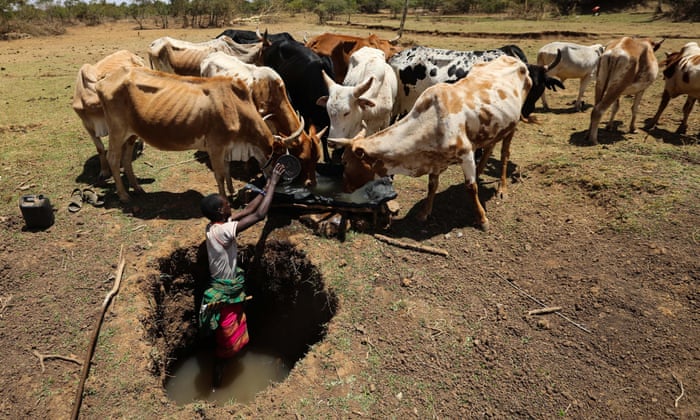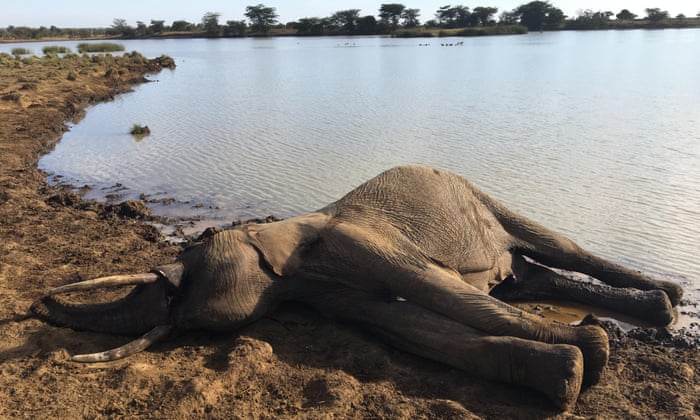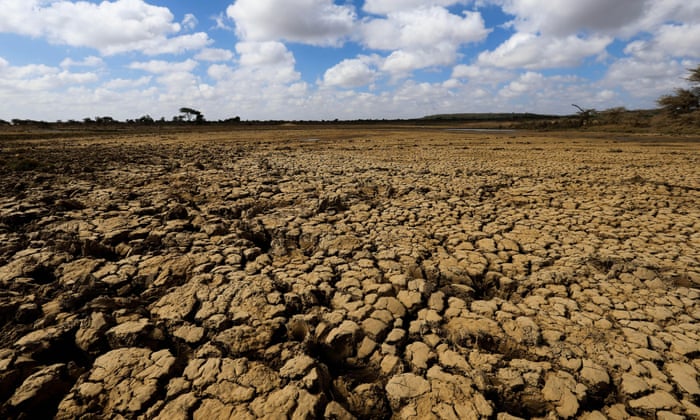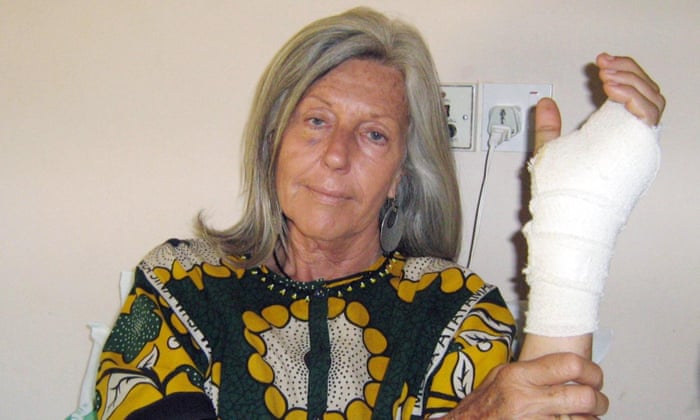Inequality, drought and the deadly fight for precious grazing land in Kenya
Arrival of hundreds of poor tribesmen seeking grazing lands for their cattle has triggered outbreak of violence in Laikipia
Herders have struggled to find water for their cattle in Laikipia. Photograph: Xinhua/SIPA USA/PA Images--An elephant carcass found at a Laikipia waterhole. The animal had been shot. Photograph: Laikipia Farmers’ Association





A dried-up pond in Laikipia county in March. Photograph: Alamy-- Kuki Gallmann in hospital after she was attacked. Photograph: Reuters
Jason Burke Africa correspondent-Wednesday 3 May 2017
 Early one morning last week, Richard Constant drove across the 24,000-acre ranch that he part-owns on a high plateau in central Kenya to discover what remained of his home.
Early one morning last week, Richard Constant drove across the 24,000-acre ranch that he part-owns on a high plateau in central Kenya to discover what remained of his home.
In March, Constant’s friend and business associate Tristan Voorspuy, a British army officer turned safari operator, had been shot dead on his horse while inspecting the damage caused by armed herders who had driven tens of thousands of cattle on to the ranch.
Constant, a 62-year-old Yorkshireman, arrived as the day’s first rays of sun fell on the ground. He heard distant gunshots, a reminder that the deadly unrest that has pitted major landowners, local smallholders and security forces against armed cattle herders for more than three months was far from over.
He found his home in ruins, burned to the ground.
“I looked at my house and felt sad that Kenya, which I regard as home, has got into such a state,” he said. “But a house can be rebuilt. I can’t get my friend back, nor the two security guards who were shot on the neighbouring ranch.”
The violence in Laikipia, one of the most spectacularly beautiful areas of Kenya, was triggered by the arrival of hundreds of poor tribesmen from drought-hit regions searching for grazing lands for their cattle.
Boris Johnson expressed concern about the unrest during a flying visit in March. The foreign secretary said the causes of the unrest were “complex”. This was an understatement.
Once known only to a few, Laikipia’s profile was boosted when Prince William proposed to Kate Middleton at a log cabin there in 2010. Tens of thousands of tourists have since travelled to the area’s ranches and reserves. Now the lucrative industry, and the livelihoods of thousands of local people, are threatened. British diplomats, among others, have called on the Kenyan government to restore the rule of law.
Estimates of the number of people killed in the violence so far range from 25 to 50, with many more wounded. One of the most high-profile of the injured is Kuki Gallmann, a best-selling author whose book I Dream of Africa was made into a film starring Kim Basinger. Gallmann, 73, was shot by herders on her 150-sq mile estate in late April.
But although international media attention has focused on Gallmann and Voorspuy, the vast majority of the dead have been Kenyan farmers. An unknown number of the tribesmen who illegally drove tens of thousands of cattle on to privately owned estates have also been killed in clashes with security forces.
There have long been tensions over land and grazing in the region. About a third of the land in Laikipia county is owned by private ranchers who mix cattle breeding with high-end tourism. Many of the owners of the biggest properties are white. Some have been farming locally for many generations. Others are more recent arrivals or, in some instances, live overseas in Europe or the US. Local herders from the Maasai tribe have been allowed to graze cattle on parts of these vast estates when times are tough, a practice that has, until now, kept tensions to a minimum.
Farmers and officials say the current situation is unprecedented. “We were one of the first properties to be taken over. At its peak there were 50,000 head of cattle [on the ranch]. They moved on after about a month, but there was a lot of damage to property and the wildlife suffered hugely,” said Josh Perrett, a manager on Mugie ranch.
Across the region dozens of elephants have been killed and their tusks removed, as well as thousands of buffaloes, antelopes and other game. Centuries-old trees have been cut down for firewood or fodder.
One reason for the violence is drought, which the Kenyan government said in October was affecting about 1.3 million people.
But ranchers like Constant said previous droughts had not caused such problems. “The difference this time is a number of politicians who promised 10,000 pastoralists with 500,000 head of cattle that if they came here and drove us out they would get to keep the land,” he said.
Kenya has a general election in August, and a new devolution of powers has made local political competitions particularly keen.
Others said opportunistic politicians were merely fuelling a fire that had burned for years. A steep population increase in Kenya, as elsewhere in Africa, has led to massive pressure on land.
Economic growth, the emergence of a new class of “cattle barons” and years of sufficient rainfall have boosted cattle numbers, and poor management has meant grazing in the north is now insufficient for the huge herds.
Some local media have been critical of the invasions, describing “heavily armed local bandits – disguised as herders – [who] ravage through multimillion-dollar investments”.
Though ranches owned by both white and black people have been overrun, and powerful Kenyans including a former chief of the army and a former speaker of the national assembly have seen their holdings occupied by armed raiders, the conflict has also been framed by some as between white “haves” and black “have-nots”.
An article in the Nation, a local paper, published after the Gallmann attack, said: “In one corner [of Laikipia], rich aristocrats sip European champagne in cottages that are hired for Sh1 million [£7,500] a week, yet in another corner, half-naked weary women trek for kilometres in search of water.”
Many ranches were acquired during the period of British colonial rule, some as early as 1900, according to a government report. Others were purchased after Kenya became independent in 1963.
Constant, a former businessman, bought a share of the Sosian ranch 17 years ago. Other ranches are owned by extremely wealthy Europeans or Americans overseas; some by rich black Kenyans from other parts of the country.
Paula Kahumbu, one of Kenya’s leading conservationists, said that although “white landowners might have an argument, they would not get much sympathy from many Kenyans”.
“This is a historical land issue, as much as anyone would like to see this differently … but just because there has been a historical injustice that has not been resolved does not mean that taking up arms is justified. These things need to be solved in the courts or there will be more violence. The government has failed to protect both large and small landowners,” she said.
The Nation described the problems in Laikipia as “social and political” and said they brought to the fore “the inequalities in land ownership”.
“The herders are incited by some politicians to invade the ranches with the belief that the land belonged to their forefathers and was forcibly taken away from them by the colonial administration. Land ownership is a powder keg and requires just a trigger to explode,” the newspaper said.
Experts said the invading herdsmen did not have any historical claim to Laikipia. Constant said the white farmers were victims of “inverse racism” and “old prejudices”.
“We came here and invested and the people who work for us are truly grateful. We have built schools, given medical care. It’s not colonialism … it’s about building a modern business,” he said.
Gallmann is a polarising figure. A former Italian socialite, she moved to Kenya more than 40 years ago with her second husband, who bought a huge estate. Already widowed by a car accident, she lost her teenage son to a snake bite. The tragedy inspired her to turn the property into the Laikipia Nature Conservancy, which includes community projects and a tourist business.
Gallmann was trying to assess damage caused by herders who had burned down one of her lodges when she was attacked.
“If I write something expressing my sympathy for her being shot, I’ll get attacked; if I don’t, I’ll get attacked too,” said Kahumbu, the environmentalist. “There are two very divergent narratives and there doesn’t seem to be any connection … and that is a very dangerous situation to have.”
For the moment there is widespread hope that rains due in the coming weeks will lower tensions, and that once the election is out of the way there will be calm.
But Kahumbu said this was unlikely. “The problem of land distribution will not go away. Even after the election it will continue to fester and erupt. As long as people think there has been an injustice, there will be a problem.”

